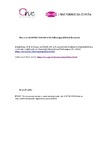Life cycle assessment of radioactive materials from a residential neighbourhood

Use este enlace para citar
http://hdl.handle.net/2183/35163
A non ser que se indique outra cousa, a licenza do ítem descríbese como Creative Commons Attribution-NonCommercial-NoDerivs 4.0 International (CC-BY-NC-ND)
Coleccións
Metadatos
Mostrar o rexistro completo do ítemTítulo
Life cycle assessment of radioactive materials from a residential neighbourhoodData
2022Cita bibliográfica
Nematchoua, M. K., & Orosa, J. A. (2022). Life cycle assessment of radioactive materials from a residential neighbourhood. Sustainable Materials and Technologies, 33, e00468. https://doi.org/10.1016/j.susmat.2022.e00468
Resumo
[Abstract] This study was carried out, with the as main purpose to evaluate the impacts of the energy mix on the radioactive material generated by a residential neighbourhood. To achieve this objective, the same neighbourhood design is applied in 150 countries, but four parameters are adapted to each country: energy mix, local climate, building materials and occupants' mobility. In addition, this research evaluates the induced radioactive material of the neighbourhood over a life cycle of 100 years and examines the impact of mobility and photovoltaic panel on this environmental impact. This environmental impact was evaluated by the Pleiades ACV simulation software under four phases (construction, use, renovation, and demolition). Among the four local parameters (energy mix, local materials, climate, and transport), the energy mix has the most significant effect on the radioactive material. The results show that the countries having a higher concentration of nuclear sources have higher radioactivity waste than others. The implementation of the new scenario of photovoltaic allows reducing the 10% of radioactivity waste. Globally, 26.8% and 37.1% of radioactivity waste were produced by electricity and building materials, respectively.
Palabras chave
Radioactive material
Neighbourhood
Countries
LCA
Neighbourhood
Countries
LCA
Versión do editor
Dereitos
Creative Commons Attribution-NonCommercial-NoDerivs 4.0 International (CC-BY-NC-ND)






